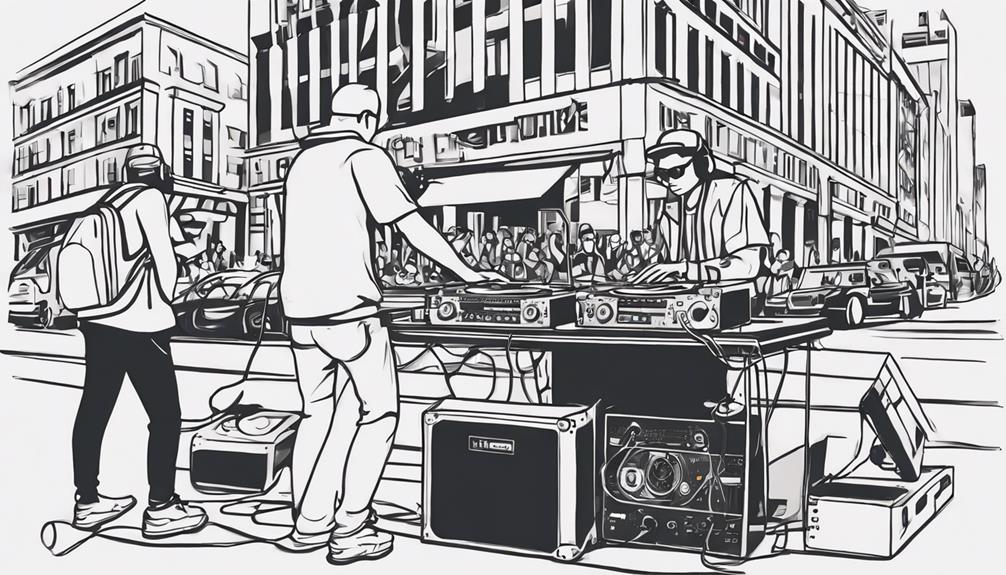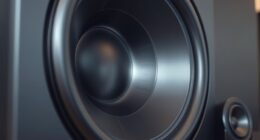To learn music production on your own, start by setting up a dedicated home studio with good acoustics and ergonomic equipment. Choose a DAW that suits your music style, invest in quality gear like studio monitors and microphones, and grasp music theory fundamentals. Experiment with recording techniques and explore mixing and mastering essentials for professional sound quality. Immerse yourself in virtual instruments for varied sounds and seek guidance from online platforms, communities, and resources. This DIY guide will kickstart your music production journey!
Key Takeaways
- Set up a dedicated home studio with good lighting and minimal noise.
- Choose the right DAW based on genre compatibility and features.
- Invest in essential equipment like studio monitors, audio interface, and quality microphones.
- Learn music theory basics like scales, chords, and key signatures.
- Utilize online resources, tutorials, and communities for self-learning and improvement.
Setting Up Your Home Studio
When setting up your home studio, make sure you choose a dedicated space with good lighting and minimal noise for maximum productivity.
Creating an ergonomic positioning for your equipment is vital to guarantee comfort and efficiency during long production sessions.
Invest in sound treatment like foam panels to enhance the acoustics of your home studio setup. These panels can help in reducing unwanted echoes and reverberations, ultimately enhancing the quality of your recordings.
Additionally, optimizing your studio acoustics by correctly positioning your studio monitors is essential for accurate sound reproduction. Placing them at ear level and ensuring they're equidistant from you can make a significant difference in how you perceive your mixes.
If you're on a budget, consider DIY solutions like creating your own acoustic panels using readily available materials. These affordable options can effectively improve the acoustics of your home studio space, making it a more conducive environment for music production.
Choosing the Right DAW
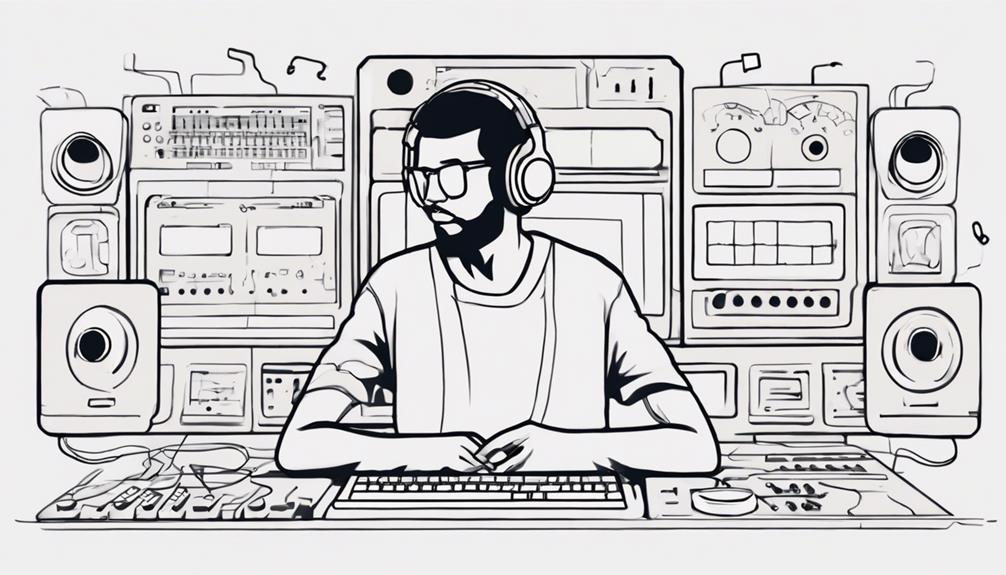
Selecting the appropriate DAW for your music production endeavors requires careful consideration of your music style and workflow preferences. When it comes to choosing the right DAW, keep the following factors in mind:
- Music Genre Compatibility: Make sure the DAW you choose aligns with the specific requirements of your music genre.
- Available Options: Explore popular DAWs like Ableton Live, FL Studio, Logic Pro, Pro Tools, and Studio One to find one that suits your needs.
- Feature Evaluation: Assess the features, user interface, and plugin offerings of each DAW to determine which aligns best with your production style.
- Trial Versions: Take advantage of trial versions or demos to get hands-on experience with the functionality of different DAWs before committing to a purchase.
- Seek Recommendations: Gather insights from experienced producers or online communities to gain perspectives on the strengths and weaknesses of various DAW options.
Essential Home Studio Equipment
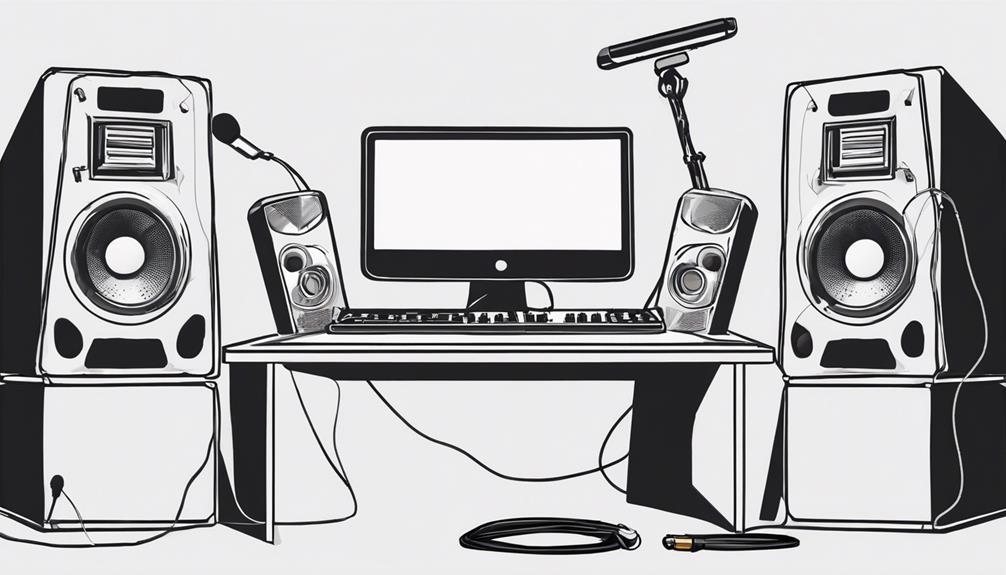
Consider equipping your home studio with essential gear like a computer, Digital Audio Workstation (DAW), studio monitors, audio interface, and quality microphones to kickstart your music production journey.
Studio monitors and audio interfaces play an important role in ensuring accurate sound reproduction and capturing high-quality audio. Investing in monitoring equipment like studio headphones and reference monitors can help you fine-tune your mixes and make informed production decisions.
Additionally, having a MIDI controller allows for hands-on control of virtual instruments and software parameters, enhancing your creative workflow.
To improve the acoustics of your home studio, consider investing in acoustic treatment such as foam panels or bass traps. These can help minimize unwanted reflections and enhance the overall sound quality of your recordings.
Lastly, quality microphones, including condenser and dynamic types, are essential for capturing vocals, instruments, and other audio sources with clarity and precision in your home studio setup.
Understanding Music Theory Basics
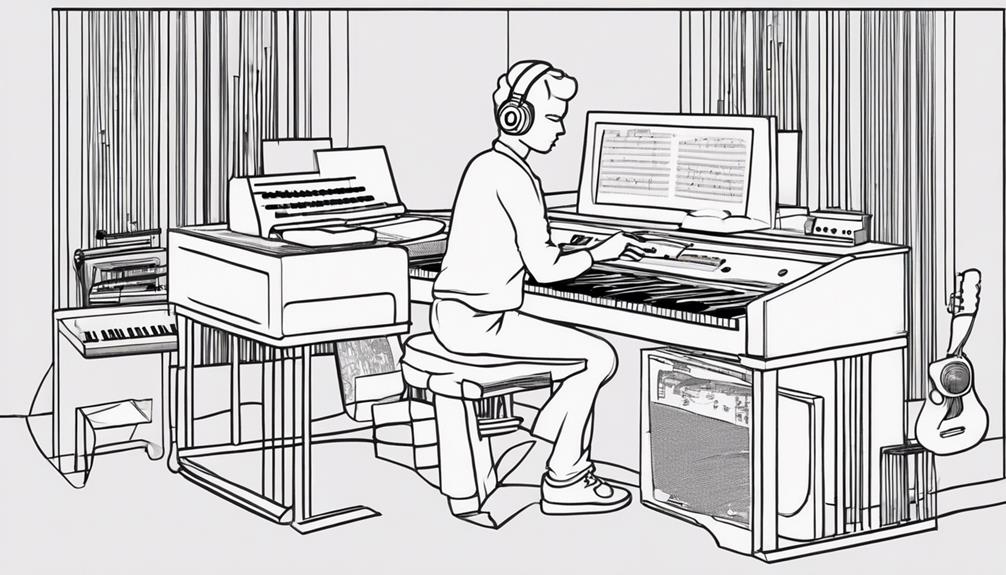
To grasp music theory basics, start by understanding scales, chords, and rhythm.
Key signatures and time signatures play an essential role in music theory, assisting you in creating cohesive compositions.
Delving into intervals and harmonies will help you craft engaging melodies and harmonies for your music.
Key Signatures Explained
Understanding key signatures is fundamental for grasping the basics of music theory. Key signatures in music indicate the tonal center and key of a piece. They consist of sharps (#) or flats (b) placed at the beginning of a staff, each representing a specific scale and set of notes.
Common key signatures include C major (no sharps or flats) and G major (1 sharp). Learning key signatures is vital for music production as it helps you compose, arrange, and analyze music effectively.
Here are five essential points to remember:
- Key signatures indicate the tonal center of a piece.
- Sharps or flats in key signatures affect specific notes in the music.
- Each key signature corresponds to a particular scale.
- Understanding key signatures is essential for composing music.
- Key signatures play a significant role in arranging and analyzing music structures.
Chord Progressions Simplified
Chord progressions form the backbone of a song's harmonic structure, dictating its emotional flow and cohesion. Understanding music theory basics is essential for crafting compelling chord progressions. By grasping concepts like scales and chord relationships, you can elevate your music production skills.
Common progressions such as the I-IV-V are fundamental in creating catchy tunes. Delving into borrowed chords and modal interchange opens up new possibilities, adding depth and uniqueness to your progressions. Experimentation is key; don't be afraid to break traditional rules to discover innovative sounds.
Learning about different scales not only expands your musical palette but also helps you create diverse and interesting progressions. Remember, the beauty of music production lies in the exploration and fusion of various elements like chord progressions, music theory, and scales.
Keep honing your skills, and soon you'll be crafting harmonically rich compositions that captivate listeners.
Recording Techniques Overview
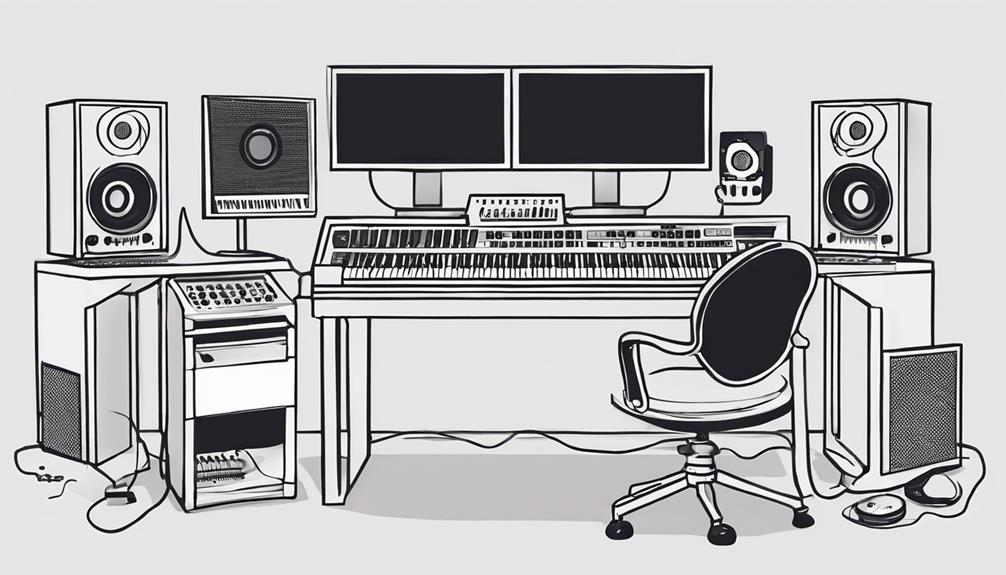
You're about to explore essential recording techniques that will elevate the quality of your music productions.
Discover the power of microphone placement, room acoustics, and signal chains in achieving high-quality recordings.
Get ready to experiment with various methods to capture vocals, instruments, and external sounds for a professional touch.
Basic Recording Tools
When diving into basic recording tools for music production, start by selecting the right digital audio workstation (DAW) to work with.
To guarantee quality recordings, invest in essential tools like audio interfaces, condenser microphones, and acoustic treatment for your recording space.
Here are some key points to keep in mind:
- Audio Interfaces: Choose a reliable audio interface to connect your instruments and microphones to your computer for high-quality audio capture.
- Condenser Microphones: Opt for condenser microphones known for their sensitivity and ability to capture detailed sound, perfect for vocals and acoustic instruments.
- Acoustic Treatment: Improve the sound quality of your recordings by treating your recording space with acoustic panels or foam to reduce echoes and unwanted noise.
- Microphone Placements: Experiment with different microphone placements to find the best position for capturing the desired sound accurately.
- Room Acoustics: Enhance your recordings by taking into account room acoustics and making adjustments to create a more controlled sound environment.
Mixing and Mastering
To achieve professional sound quality in your music production, mastering the art of mixing is essential for balancing and blending instruments effectively within a track. Mixing involves adjusting volumes, panning, and shaping tones to create a cohesive sound.
Utilizing plug-in effects such as compression, EQ, reverb, and delay is important for achieving a well-balanced mix. Once the mixing process is complete, mastering takes over as the final step in music production. Mastering adds finishing touches like EQ adjustments, compression, stereo enhancement, and limiting to guarantee tracks sound polished and consistent across an album.
Learning audio editing techniques is also crucial in tightening timing, structuring songs, and enhancing overall sound quality. By mastering the skills of mixing, mastering, and audio editing, you can elevate your music production to a professional level and create tracks that stand out with clarity and precision.
Mixing and Mastering Essentials
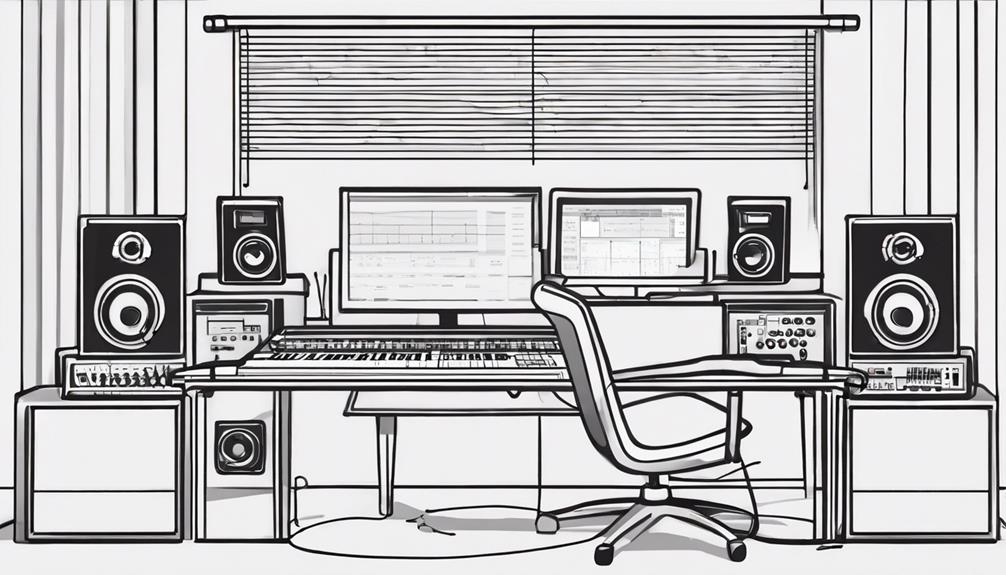
Understanding the fundamentals of mixing and mastering is essential for aspiring music producers aiming to achieve professional sound quality in their tracks. When diving into the world of audio production, mastering the art of mixing and mastering can truly elevate your music to the next level. Here are some key essentials to keep in mind:
- Balancing Act: Mixing involves balancing levels, panning, EQ adjustments, and effects to create a cohesive and balanced sound.
- Final Touches: Mastering focuses on fine-tuning tracks with EQ adjustments, compression, limiting, and enhancing overall clarity.
- Reference Tracks: Utilize reference tracks to compare mix balance and master quality, helping you achieve a professional sound.
- Plugin Playground: Experiment with different plugins and techniques to develop your unique mixing and mastering style.
- Educational Resources: Online tutorials and courses are valuable assets for learning advanced mixing and mastering techniques independently.
Exploring Virtual Instruments
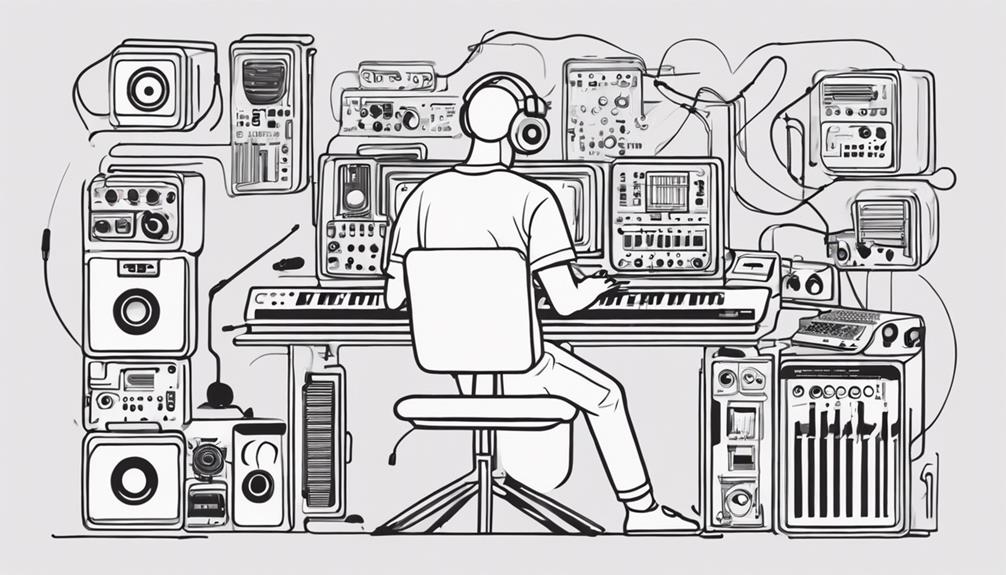
Exploring virtual instruments opens up a world of diverse sounds and tones for music production, expanding your creative possibilities beyond traditional instruments.
Virtual instruments, such as synthesizers and drum machines, offer a vast range of options from orchestral instruments to unique effects.
Plugins like Serum, Kontakt, Omnisphere, and Massive are popular choices that provide flexibility and customization to shape your sound.
Resources for Learning Music Production
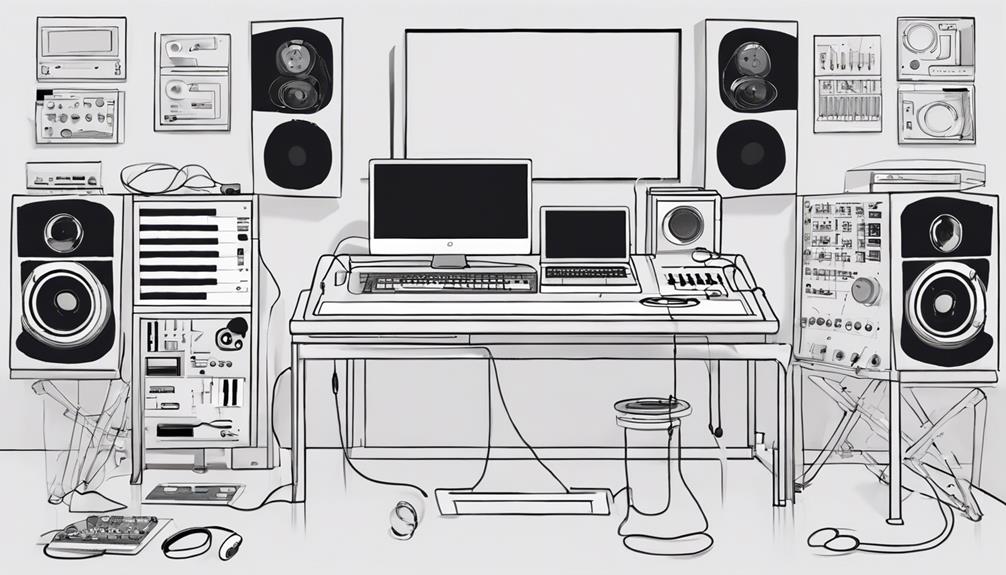
Discover a plethora of resources available for learning music production to enhance your skills and knowledge in the field. Whether you’re a beginner or an experienced producer, there are countless tutorials, forums, and online communities to help you grow. Many platforms offer opportunities to learn music production for free, ranging from YouTube videos to open-access courses provided by industry experts. By taking advantage of these resources, you can deepen your understanding of music theory, sound design, and mixing techniques without spending a dime.
When diving into the world of music production, consider the following resources:
- Utilize online platforms like YouTube, Udemy, and Coursera for free and paid music production tutorials.
- Join online forums and communities like Gearslutz and Reddit's r/WeAreTheMusicMakers for advice and feedback from experienced producers.
- Explore websites like Sound on Sound, MusicTech, and Future Music for articles, reviews, and guides on music production techniques.
- Consider investing in books like 'Mixing Secrets for the Small Studio' by Mike Senior or 'The Dance Music Manual' by Rick Snoman for in-depth knowledge.
- Attend music production webinars, workshops, and virtual events hosted by industry professionals to learn new skills and techniques.
Frequently Asked Questions
How Do I Learn Music Production by Myself?
You learn music production by yourself through online resources, experimenting with various digital audio workstations, practicing consistently, setting specific goals, joining online communities, and analyzing professional tracks for insights. Consistency and engagement are key.
Can You Teach Yourself to Be a Music Producer?
You can certainly teach yourself to be a music producer. Immerse yourself in online resources, tutorials, and practice. Experiment with various digital audio workstations (DAWs), join communities for feedback, and consistently practice and analyze tracks to improve your skills.
How to Learn Music Production at Home for Free?
To learn music production at home for free, utilize online resources like YouTube tutorials and free DAW trials. Join music production communities, explore virtual instruments, and take free online courses. Enhance your skills without breaking the bank.
What Is the Fastest Way to Learn Music Production?
So, you wanna fast-track your music production skills, huh? Dive deep into online tutorials, practice religiously, experiment with diverse genres, seek feedback, and keep up with trends. That's the turbo boost you need!
Conclusion
So, now that you have all the tools and knowledge to start learning music production on your own, don't let the fear of not having formal training hold you back.
Remember, practice makes perfect, and with dedication and creativity, you can achieve your music production goals.
Don't worry about not being a technical expert right away – everyone starts somewhere, and the most important thing is to just start creating and having fun with it.






